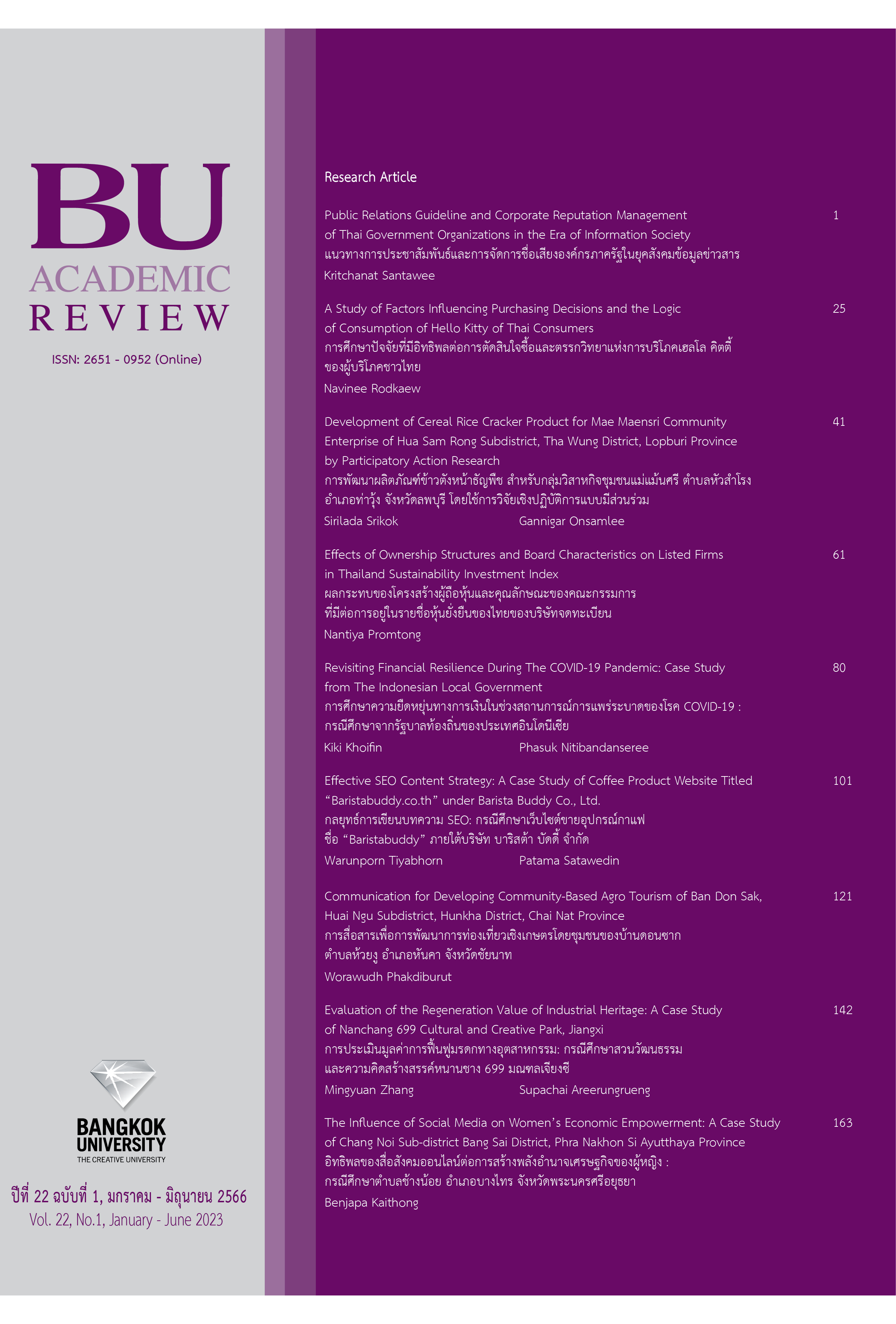การประเมินมูลค่าการฟื้นฟูมรดกทางอุตสาหกรรม: กรณีศึกษาสวนวัฒนธรรมและความคิดสร้างสรรค์หนานชาง 699 มณฑลเจียงซี
Main Article Content
บทคัดย่อ
จากความล้ำสมัยของวิทยาศาสตร์และเทคโนโลยีรวมถึงความก้าวหน้าแบบก้าวกระโดดของวงการอุตสาหกรรม ทำให้การพัฒนาอุตสาหกรรมในอดีตที่กว้างขวางมีการสูญเสียความสามารถในการแข่งขันลงทีละน้อยในข่วงต้น ปี1990 และต้องเผชิญกับการล้มละลายและปิดกิจการลง ผลลัพธ์จากสภาวะดังกล่าวคือโรงงานอุตสาหกรรมเก่าจำนวนมากถูกปล่อยทิ้งร้างไม่มีการใช้งานและต่อมาศูนย์รวมวัฒนธรรมโรงงานกลายเป็นที่สะสมความทรงจำอันล้ำค่าของผู้คน ซึ่งการรีไซเคิลมรดกทางอุตสาหกรรมในศูนย์รวมโรงงานจึงมีความสำคัญต่อการพัฒนาระบบนิเวศอย่างยิ่ง เมื่อพิจารณาขยะที่เหลือเป็นมรดกในพื้นที่โรงงาน เช่น หิน ไม้ โลหะ แก้ว ล้วนเป็นทรัพยากรที่ไม่สามารถหมุนเวียนกลับมาใช้ใหม่ เพื่อให้เกิดการนำทรัพยากรเหล่านี้มาใช้อย่างสมเหตุสมผล จึงจำเป็นต้องมีการฟื้นฟูสภาพมรดกทางอุตสาหกรรมขึ้นมาใหม่ ผ่านการสำรวจที่ผสมผสานระหว่างการพัฒนาที่ยั่งยืนและการพัฒนาเศรษฐกิจด้านระบบนิเวศ การดำเนินการดัดแปลงอาคารอุตสาหกรรมและใช้กระบวนกาทางศิลปะจัดการเหล่าวัสดุขยะจากอุตสาหกรรมอย่างมีหลักกา และสมเหตุสมผลเพื่อรังสรรเป็นสิ่งของใหม่ที่มีมูลค่าเชิงพาณิชย์ ด้วยการวิจัยเชิงระบบที่ศึกษาเกี่ยวกับการประเมินการฟื้นฟูมรดกทางอุตสาหกรรม วิทยานิพนธ์ชิ้นนี้ได้ดำเนินการศึกษาตามหลักการและภายใต้แนวคิดทฤษฎีสำหรับการประเมินมูลค่าของสวนหนานชาง 699 สวนวัฒนธรรมและเสริมความคิดสร้างสรรค์ในมณฑลเจียงซี ผลจากการศึกษาแสดงให้เห็นว่ามูลค่าเชิงพาณิชย์ของสวนหนานชาง 699 มีสูงกว่ามูลค่าเดิมเล็กน้อยทั้งสภาพภายในและภายนอก อย่างไรก็ตาม การสร้างมูลค่าเชิงพาณิชย์นั้นขึ้นอยู่กับมูลค่าในสภาพดั้งเดิมก่อนหน้าของโรงงานเหล่านั้น เช่น ความเป็นมาทางประวัติศาสตร์ ความเป้นมรดกทางวัฒนธรรม สภาพโครงสร้างทางสิ่งแวดล้อม รวมถึงการหนาแน่นของผู้คนพื้นที่พักอาศัยซึ่งล้วนพึ่งพาอาศัยกันและมีอิทธิพลต่อกัน นากการเปรียบเทียบค่าน้ำหนักจากระบบการประเมินและการวิเคราะห์ผล พบว่า ผลการศึกษามีนัยสำคัญที่ส่งผลต่อการกำหนดทิศทางและกลยุทธ์การพัฒนา
Article Details

อนุญาตภายใต้เงื่อนไข Creative Commons Attribution-NonCommercial-NoDerivatives 4.0 International License.
บทความที่นำมาสมัครลงตีพิมพ์ในวารสารต้องไม่เคยได้รับการตีพิมพ์เผยแพร่มาก่อน และไม่ส่งต้นฉบับบทความซ้ำซ้อนกับวารสารอื่น รวมทั้งผู้เขียนบทความต้องไม่ละเมิดหรือคัดลอกผลงานของผู้อื่น
เอกสารอ้างอิง
Al-Hagla, K. S. (2010). Sustainable urban development in historical areas using the tourist trail
approach: A case study of the Cultural Heritage and Urban Development (CHUD) project
in Saida, Lebanon. Cities, 27(4), 234–248. https://doi.org/10.1016/j.cities.2010.02.001
Cao, C. M. (2011). The analysis of Guangxi's cultural and creative industries development. In 2011 IEEE 18th International Conference on Industrial Engineering and Engineering Management (pp.2110-2113). Changchun, China: IEEE.
Carvalho, C. S., Forester, B. R., Mitre, S. K., Alves, R., Imperatriz-Fonseca, V. L, Ramos, S. J., Resende-Moreira, L. C, Siqueira, J. O., Trevelin, L. C., Caldeira, C. F., Gastauer, M., & Jaffé, R. (2021). Combining genotype, phenotype, and environmental data to delineate site-adjusted
provenance strategies for ecological restoration. Molecular Ecology Resources, 21(1), 44–58. https://doi.org/10.1111/1755-0998.13191
Chemat, F., Rombaut, N., Meullemiestre, A., Turk, M., Perino, S., Fabiano-Tixier, A.-S., & Abert-Vian,
M. (2017). Review of green food processing techniques. Preservation, transformation, and
extraction. Innovative Food Science & Emerging Technologies, 41, 357–377. https://doi.org/10.1016/j.ifset.2017.04.016
Cheng, H., & Hu, Y. (2010). Planning for sustainability in China’s urban development: Status and challenges for Dongtan eco-city project. Journal of Environmental Monitoring, 12(1), 119–126. https://doi.org/10.1039/B911473D
Daher, R. (2005). Urban regeneration/heritage tourism endeavours: the case of Salt, Jordan ‘Local actors, International donors, and the state’. International Journal of Heritage Studies, 11(4), 289–308.
Doratli, N., Hoskara, S., & Fasli, M. (2004). An analytical methodology for revitalization strategies in historic urban quarters: a case study of the Walled City of Nicosia, North Cyprus. Cities, 21(4), 329–348.
Freeman, R. (2001). Single-peaked versus diversified capitalism: The relation between economic
institutions and outcomes. Income J. Drèze (Ed), Advances in Macroeconomic Theory (pp. 139–170). UK: Palgrave Macmillan.
Li, M., Wu, B., & Cai, L. (2008). Tourism development of world heritage sites in China: A geographic perspective. Tourism Management, 29(2), 308–319. https://doi.org/10.1016/j.tourman.2007.03.013
Liuzza, C. (2008). The ICOMOS ENAME carter for the interpretation and presentation of cultural heritage sites: The initiative, its development and its future applications. Retrieved May 1, 2023, from http://www.vziliao.com/Entrance/Open/1469c1d7-5c4e-4b28-a72f-15ddc89d835a
Mazzanti, M. (2013). Valuing cultural heritage in a multi-attribute framework microeconomics perspectives and policy implications. Journal of Behavioral and Experimental Economics, 32(5), 549–569.
Mesik, J. (2007). Community foundations: A tool for preservation of cultural heritage in social development notes. Social Development Notes Community Driven, 108, 1-4.
Ngidi, L. (2018). Assessing the inclusiveness of urban regeneration projects: the case study of point
waterfront development precinct, Durban (Masters’ Thesis, University of KwaZulu-Natal).
Osman, K. A., & Farahat, B. I. (2018). The conservation of the waterfront of Saida: A model for
tourism and culture-led revitalization in valuable areas. HBRC Journal, 14(3), 321–333. https://doi.org/10.1016/j.hbrcj.2017.02.003


